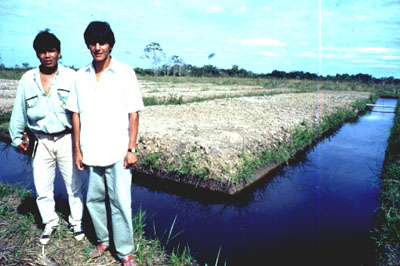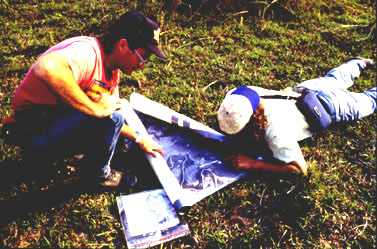
By Ellen K. Coughlin

For four or five months at a stretch, much of the vast savanna of Llanos de Moxos in northeastern Bolivia is under water. For the rest of the year, the flat landscape lies parched under the tropical sun.
An environment like that would seem to be good for little, least of all for farming. But the prehistoric peoples of the region did farm their land, on a vast scale. They were able to do so, for hundreds of years, because they came up with an ingenious response to the alternating floods and dry spells: Build the growing fields up above the water level and surround them with canals to capture the excess moisture.
Clark L. Erickson thinks those ancient farmers have something to teach their late-20th-century descendants.
Since 1990, Dr. Erickson, an archaeologist at the University of Pennsylvania, has been studying the remains of raised-field farming systems in the Llanos de Moxos that date back some 2,000 years. More than a traditional archaeological dig, however, the project he heads is also an experiment in building and farming raised fields. He and his colleagues want to learn not only how the ancient system might have worked, but also whether it might be put to use again by the peasants who now live in the region.
"I'm convinced that, technologically, this system is sound," Dr. Erickson says. "It's great. It's sustainable agriculture."
The Llanos de Moxos, which roughly coincides with the political boundaries of the Bolivian department (or state) of the Beni, lies east of the Andes in the area of South America known as Amazonia. The tropical lowlands are mostly flat savanna, or grassland, with some stands of dense forest on higher ground along the rivers. For much of the rainy season, from December through May, the savanna is covered by a thin sheet of water, although at certain times and places the ground may be several feet under.
Through the 1950's, experts believed that such an inhospitable environment could not have supported a large, culturally advanced population. In 1961, however, William M. Denevan, a geographer recently retired from the University of Wisconsin at Madison, working with an oil-company geologist, found the remains of prehistoric raised fields in the Llanos de Moxos.
"The Amazon is an area of very poor soils," he says. "Add to that the problem of flooding. To find that these areas were once cultivated was quite dramatic."
Today, several hundred years after the fields fell out of use, the plots have eroded some and the canals have filled in, creating a washboard pattern in the landscape that can be most easily seen in aerial photographs (or felt, if you happen to be driving across them).
Dr. Denevan says he surmised almost immediately that they were agricultural fields, largely because they couldn't have been anything else.
Dr. Denevan was among the earliest discoverers of ancient raised fields in the New World; he and other researchers have since found similar fields at sites throughout the Americas. Dr. Erickson is the first to study archaeologically Dr. Denevan's original, 1961 find.
Based on data gleaned from their digs, Dr. Erickson and his colleagues believe that at least one block of raised fields in the Llanos de Moxos dates to about 100 B.C. and was cultivated until about A.D. 1100.
The rectangular plots were built up roughly three feet above ground level, and were from 10 to 30 feet wide and from 100 to 1,300 feet long. Between the fields were canals, also 10 to 30 feet wide, that had been excavated to a depth of about three feet below ground level.
The excavated fields have provided a lot of information about phases of construction and the crops that were grown. But the ancient soil cannot tell researchers all they want to know, including such things as how productive the fields were or how much labor was required to build and maintain them -- or why the system had been largely abandoned by the time the Spanish arrived in the 16th century. To try to answer some of those questions, Dr. Erickson turned to a method known as "experimental archaeology," which involves recreating things like ancient dwellings or tools as a way to determine how they might have been made and used.
In the summer of 1990, Dr. Erickson and his colleagues, with the help of local farmers, constructed a small block of raised fields at the Biological Station of the Beni, a government-run research center about 150 miles west of Trinidad, the department capital. Data gathered by members of Dr. Erickson's project -- added to information from research on raised-field sites elsewhere -- reveal a good deal about why ancient farmers found the system advantageous.
Raising the fields, for example, increases the thickness of the topsoil in the area where crops are grown. The canals not only hold excess rain water, but also provide drainage for plots that would otherwise be water-logged. Muck from the bottom of the canals is rich in nutrients and can be used as a kind of "green manure" for the fields.
The proof, though, is in the plants. Among the crops Dr. Erickson has cultivated are bananas, maize, and beans, and their yields have usually exceeded those of local peasants using slash-and-burn methods. In the 1992-93 growing season, when heavy rains rotted the plants in groundlevel plots, the raised fields produced the only manioc (cassava) in the area.
Dr. Erickson's scholarly work on the Bolivian raised fields also has a practical side. Unlike many other archaeologists, he is an active proponent of applying ancient knowledge to future development. In the Llanos de Moxos, he and his Bolivian colleagues are attempting to re-introduce the raised-field system as a viable means of economic support for the region's farmers.
It is an effort with which Dr. Erickson has had some experience. As a graduate student in the late 1970's and early 80's, he spent several years studying raised-field agriculture in the Peruvian highlands near Lake Titicaca. He put a $500 grant toward the construction of a small experimental field, and the results were so successful that the project was expanded.
"It caught on," he says. "There are a lot of communities building the fields now in the highlands."
A similar archaeological project, begun several years later in the Bolivian highlands by Alan L. Kolata of the University of Chicago, has had similar success. In 1988, Dr. Kolata says, his team worked with two communities to construct and cultivate raised fields; today 57 communities are using the system. "It's growing mostly of its own accord now, from family to family," he says.
Dr. Erickson hopes to duplicate the highlands experience in the lowlands. As usual, much depends on the availability of funds. For the last three years, a grant from the Inter-American Foundation has supported the cultivation of a few small blocks of raised fields in two communities. Dr. Erickson is looking for money to expand the project to 10 more communities.
The idea is not always an easy sell, he says. Some communities decide the plots aren't worth the labor involved, but others readily sign on. An offer of wages sometimes makes the difference. "These are very poor people, and they're looking for an alternative," Dr. Erickson says.
It has also helped that the fields have produced bumper crops so far.
Dr. Erickson's work dovetails neatly with political developments in Bolivia. In recent years, the government has begun to grant official recognition to indigenous groups, giving them the necessary clout to make serious land claims. How that land is to be managed is a big issue in Bolivia's political future. Dr. Erickson and others, including Dr. Kolata of Chicago, believe that raised-field agriculture could be a key to the sustainable development of indigenous territories.
Raised fields, Dr. Erickson argues, can be built with simple tools, and do not require the large financial and technological investment that many third-world development projects call for. The initial construction of the fields is labor intensive, he adds, but subsequent maintenance is not, making the fields relatively cost-effective.
"We're finding more and more," Dr. Erickson says, "that even small families can build raised fields."
Dr. Erickson recalls writing a report on Bolivia when he was in grade school. But he didn't really get hooked until, as an undergraduate, he got the chance to join one of his professors for a summer's field work there. "I was asked at the last minute," he says. "I knew no Spanish. I was like a fish out of water. But I really loved it."
Now, he says, he's committed for the long haul. He has enough research support from the National Science Foundation to cover one more field season this summer. After that he will spend a year or two writing up his research and looking for grants to carry him into the next stage of his work.
He plans to continue his development efforts in the Llanos de Moxos, at least until he has enough solid data to persuade development authorities that raised-field agriculture is worth pursuing.
But he also wants to start taking a broader view of the ancient raised fields. He's interested, for example, in what the landscape reveals about the social organization of the prehistoric peoples who created it. And he'd like to try to figure out why the fields were so elegantly designed: Perhaps they served some astronomical or calendrical function, or followed some rules dictated by the ancient culture.
"These are issues," he says, "that can get at the prehispanic mind of the peoples."



| You are the |